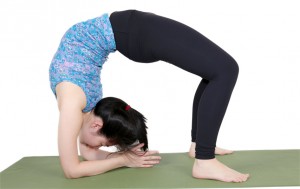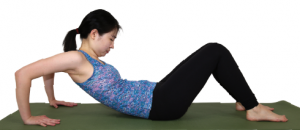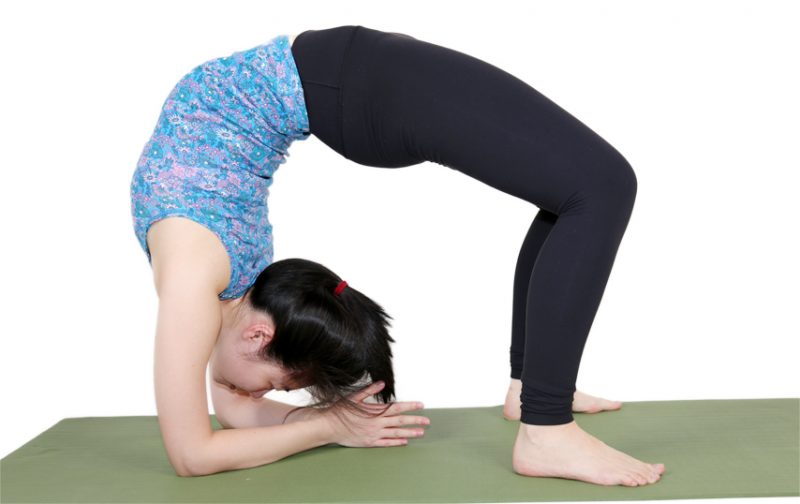Vipareetha (or Viparita) Dandasana is derived from the terms “Vipareetha” or inverted, “danda” or staff and “asana” or pose.
This is a chest-opening pose that promotes blood circulation, activates the abdominal organs and stretches the deeper layers of the back muscles.
In terms of anatomy, backward bending poses generally strengthen the spine, improve breathing capacity and give a good stretch to the abdomen, chest & shoulders, all while creating space in the spine and adding flexibility to the body. With practice, this pose can be a soothing pose to the mind and it is recommended to those who are facing emotional distractions such as anxiety or stress.
Chakra Awareness
Anahata Chakra / heart
Practice Level
Intermediate
Degree of Difficulty (100 being most difficult)
70
Movement
Backward Bending
A spinal movement done with the extension of the spine, supported by different back muscles.
Shoulder Girdle Elevation Upward Rotation
A lateral and upward movement of the scapula or shoulder blades.
Challenges Faced During The Practice
Chest tightness and breathing difficulty
Back limitation
Lightheadedness
Shoulder strength
Chances of Injury
Back compression
Contraindications
Existing back, neck or spinal injury
High or low blood pressure
As the top of the head goes upside down, those with irregular blood pressure might feel lightheadedness or nausea while or after doing the pose.
Hyperkyphosis
Refers to an excessive curvature of the thoracic spine, commonly referred to as hunchback. As this is a backward bending pose, having a hunched back poses a difficulty in achieving the pose.
Major Muscles Involved
Rectus Abdominis
It is responsible for the flexing of the lumbar spine and keeping the internal organs intact, therefore working with the Erector Spinae especially in backward bending movements.
Erector Spinae
A muscle group found in the back, which extends the vertebral column in forward and backward bending. This muscle is responsible for returning the vertebral column to the erect position after motion.
Deltoid
The muscle forming the rounded shape in the shoulders, the deltoid muscles assist and support in the abduction of the shoulder.
Pectoral
Composed of the Pectoralis Major and Pectoralis Minor, this muscle makes up most of the chest area muscles and is responsible for the movement of the shoulder joint. The Pectoralis Major keeps the arm attached to the trunk of the body while the Pectoralis Minor stabilizes the scapula.
Triceps
The large muscle on the back of the upper arm, and is primarily responsible for the extension of the elbow joint. It originates from the scapula and also acts on the movements of the arm.
Quadriceps
A large muscle group that includes the four prevailing muscles on the front of the thigh, which act as extensors of the knee joint.
Best Time to Practice
Afternoon or evening, when the body’s natural flexibility is present.
Warm-up
Supine Chest Opening (with the use of blocks)
Prepare two blocks on the floor – place a block horizontally on top of a flat block. The block is about 6 inches away from the hips.
Place the hands behind the hips and slowly lie down, with the middle back resting on the block. Make sure that the block is in the middle back, below the shoulder blades.
Hold this pose for a few subtle breaths and when ready, raise the hands over the head and hold the opposite arm’s biceps.
Benefit: The use of props is effective in creating a deeper arch by adding intensity to the stretch.
Final Pose

Push the elbows down firmly then lift the head up and look down,bounce house for sale in between the hands. Gently release the interlocked fingers and press the palms together. Breathe normally.
After several practices, try Bhastrika Pranayama (bellows breathing / forceful exhalation) for 3-5 times while holding the pose.
Counter Pose

Seated shoulder stretch
Sit with the knees bent and place the hands behind, about a foot away from the hips. The fingers are pointing forward. Inhale and on exhale, push the chest in and bend the elbows to round the back, aiming to bring the lower back to the floor. Hold the stretch for a few breaths then come up slowly. Come in and out of the pose a few times, trying to lower down the back even more after each time.
….more
To read the full article please download our Asana Journal App or purchase Issue 153 Sept 2015.





















 Other
Other